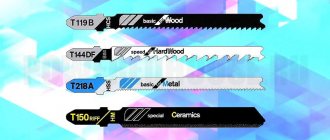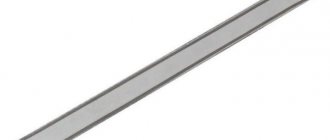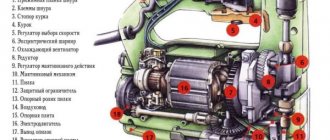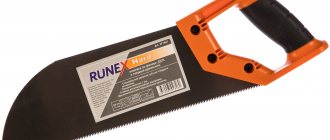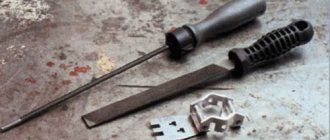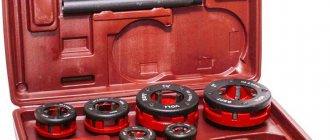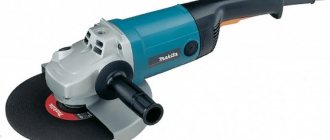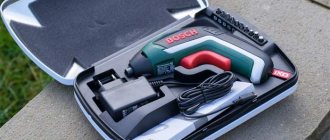What you need to know about jigsaw files
If you carefully examine the assortment of files in the store, you will notice that they differ from each other in the shape and color of the shank, the size of the teeth, and the length. None of these options affect how to insert a file into a jigsaw, unless you inherited an old Makita or Bosch tool. For the first models of these brands, files with special slots were produced, and now they cannot be found on sale.
Shank shape
When electric jigsaws first appeared, there was no single standard for saw blades. Today there is no need to look for a blade for a specific instrument model. These products are universal and suitable for all modern jigsaws. The exception is outdated models from companies such as DeWalt, Stayer, Skil, Black&Decker and some others, equipped with block or screw holders. Blades with U-shaped shanks are available for them.
Such shanks can be with or without a hole for additional fixation Source 220-volt.ru
Since not only professionals, but also most home craftsmen began to use jigsaws, all well-known manufacturers began to produce this tool. There was a need to standardize files so that they fit all models, regardless of the brand and type of holder. And now the most common are the so-called “Bosch” T-shaped shanks. The stops on the sides make them look similar to this letter.
File with T-shank Source amazon.com
On a note! Old Bosch saws were equipped with double stops.
Type of cutting blade
Before working with a jigsaw, you need to insert a blade suitable for the material being cut into it. The color of the shank will tell you which one to choose. This color marking helps you not to get confused in the variety of cutting edges, which differ not only in the size of the teeth, but also in their shape and setting.
- For wood – gray.
- For metal – blue.
- For plastic – red.
- Universal – black.
But it is not difficult to remember that the denser the material, the smaller the tooth of the cutting blade should be. For rubber and cardboard, files with a wavy edge are used, for ceramics - straight ones with an abrasive coating, for laminate - with a cutting edge on the back side of the tooth. And universal blades have variable tooth sizes.
Saw blades for jigsaw Source nix.ru
See also: Catalog of companies that specialize in finishing materials and related work
The thickness and width of the blade are also important, since a jigsaw can be used not only for rough straight cuts, but also for figured cutting. Therefore, to cut a block and create carved frames from a thin board, different wood saws are used. A complex cut with curves turns out to be much more accurate if it is made not with an ordinary file, but with a thin file.
And for even and perpendicular straight cuts, a wide blade is more suitable Source goods.ru
Advice! The length of the blade must be selected according to the thickness of the workpiece - it must pass right through it. But it is better not to use a blade that is too long for thin materials; it becomes deformed during the cutting process, and the cut is not accurate enough.
Adviсe
In order for your jigsaw to serve you for a long time, you need to follow several recommendations:
- Remember to check your tool settings before use.
- In order to avoid breaking off the material during operation, use special inserts.
- When replacing the saw blade, be careful and careful. Don't overtighten the fasteners, but don't leave them too loose either.
There are a great variety of jigsaw files. They can vary in length, thickness and shape of the teeth. Replacing the file yourself is not difficult, the main thing is to know how to do it correctly.
Types of fastenings and methods of installing files
For different tools, the jigsaw blade holder may have a different fastening design. It is located on a movable rod and together with it is subjected to heavy loads during operation of the device, which become critical when using an incorrectly selected or dull blade. Therefore, it is so important to choose the right file, monitor its condition and replace it on time.
On a note! When buying a jigsaw, pay attention to the quality of the material and workmanship of the moving part of the tool and the mounting on it. As a rule, they are the ones that break down more often than other parts and require repair.
Rod with blade holder Source drel-master.ru
The first such tools had not very convenient fastenings, but manufacturers constantly tried to make this unit as simple as possible and automate the process of installing the cutting blade in order to attract the attention of consumers to their products. As a result, different types of saw blade holders appeared, thanks to which working with a jigsaw has become much more comfortable.
The principle of fastening files in all modern devices is based on the use of mechanisms that clamp and hold the shank in a stable position. But the installation process itself varies depending on the type of holder.
Quick release holders
The most modern and convenient today are quick-release fasteners, which are equipped with most household electric jigsaws. The mechanism is activated by simply pressing the latch - a button or lever, as a result of which the fastening slot opens, and when it returns, it contracts again. The shank is inserted into this slot until it stops. There is nothing complicated about how to change a saw blade on a jigsaw: the worn one is easily removed from the loosened mount, and a new one takes its place.
Quick-release mount with side button Source onlinetrade.ru
Video description
Watch a video about installing accessories in a jigsaw with a radial clamp:
Shoe fastenings with bolts
Despite the relative complexity of fastening, jigsaws with such holders are still produced. To fix the files, they are equipped with metal blocks with holes for bolts. There can be one bolt - fastening, or two - fastening and adjusting. In older models, they have a straight slot for a flat-head screwdriver. The new slots have hexagonal holes for a special hex key that comes with the tool.
There are holders for the key on the body or cable of the tool so that it is always at hand Source onlinetrade.ru
Before inserting the blade into the jigsaw, the bolts are loosened, and after installing the shank in the slot, they are tightened again. To avoid distortions, they are tightened little by little and one at a time, controlling the position of the file using a square. This type of fastening is suitable for files with any shank shape, even outdated models.
Video description
The process of replacing equipment in a jigsaw with a jig saw is shown in the video:
If in quick-clamp fasteners the file is automatically fixed in the desired position, then in jigsaws it needs to be controlled, which for many is a noticeable disadvantage, as it takes time. In addition, it is important to correctly determine the degree of tightening of the bolts. If you clamp too hard, the blade will be very tense and may break. And if it is weak, it will fall out or dangle in the socket, and working with a jigsaw will become impossible.
The second problem with such fasteners is the abrasion of the slots on the bolts during intensive work and frequent replacement of saw blades. Often the threads of the fastener or block break and cracks appear on its body. This mainly happens with tools made in China from low-quality materials. A damaged pad cannot be repaired, it can only be replaced.
In a jigsaw machine
Changing the blades in this advanced tool is the easiest of all varieties of this saw tool. The new blade with pins is first installed in the lower and then in the upper mount so that the teeth “look” forward and down.
After this, the file is fixed using a tightening lever, usually located on top, on the opposite part.
Note!!! To replace blades without pins, special adapters are used, which are first put on and fixed at both ends of the file.
We hope that this information will help jigsaw owners to operate this reliable tool with the most effective results.
How to avoid breakdowns
An electric jigsaw is not the most complicated tool. With careful use and care, it works for a long time without breakdowns. The most vulnerable component is the movable pendulum rod with a saw blade holder, which can break and become unusable simply from frequent use of the device. Well, the files themselves also often break or become dull, but this is a natural phenomenon for any consumables.
- Dull teeth of the cutting blade have difficulty biting into the material, causing rod breakage or engine overheating.
- A bent file leads to the same consequences and leads the cut to the side.
- Overloading the motor and sticking the rod can also be caused by a lack of lubrication in the guide roller for the saw.
Smooth running depends on the movement of the guide roller Source fanera-rostov.ru
To prevent breakdowns, you need to know how to use a jigsaw correctly and pay attention to problems such as charring of wood when cutting, cutting to the side and changes in the smooth movement of the rod, runout canvases. In such cases, you need to make sure that the blade is not bent or dull. You should not try to straighten a deformed file or put aside a dull file to work with softer materials. It must be thrown away immediately.
Also, when working with the tool, you need to follow simple rules:
- monitor the integrity of the cord, avoid kinks and knots;
- before changing the file on the jigsaw, unplug it;
- do not overload the tool, let it rest or cool the engine by letting it run idle;
- do not use excessive force when sawing, which may lead to the file becoming jammed;
- Periodically clean the air intake openings to cool the engine and disassemble the device itself to remove any debris that has gotten inside.
Life hacks: How to change, replace or insert a file into a jigsaw?
Reading time: 7 minutes.
Published 05/11/2019 All types of work with wood or other materials are in one way or another connected with the process of cutting them to specified sizes and contours. Carrying out these steps manually is tedious and unproductive work, so various mechanized devices have been created to make this procedure easier.
Initially, only large stationary machines were created that were capable of cutting large objects - logs, stones. Later, devices were developed to make it easier to work with small fragments of building or finishing material. Finally, hand-held power tools were developed, which significantly changed the approach to work and the productivity of the individual craftsman.
The modern market is replete with similar tools, a bright and unique representative of which is the jigsaw. Let's take a closer look at its features.
Briefly about the main thing
Before starting to use a power tool, novice craftsmen should definitely read the instructions for it. But you don’t always have to work with new equipment, and used ones may not have the instructions. If you need to know how to install a saw blade in a jigsaw, read this article, which describes all types of holders and explains how to attach the work blade. You will also learn how to prevent wear of fastening units and replace them in case of breakage, which saw blades to use for different materials and models of jigsaws.
Ratings 0
